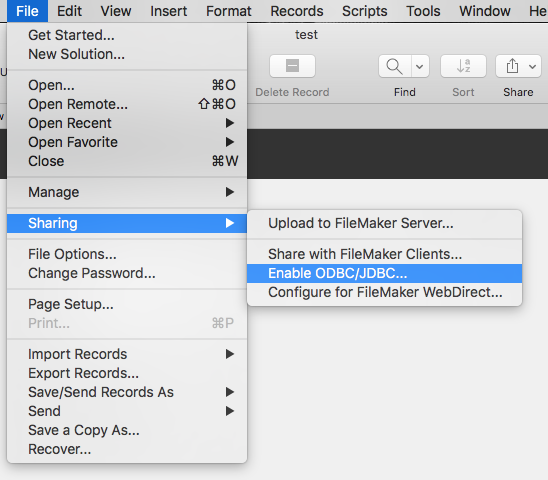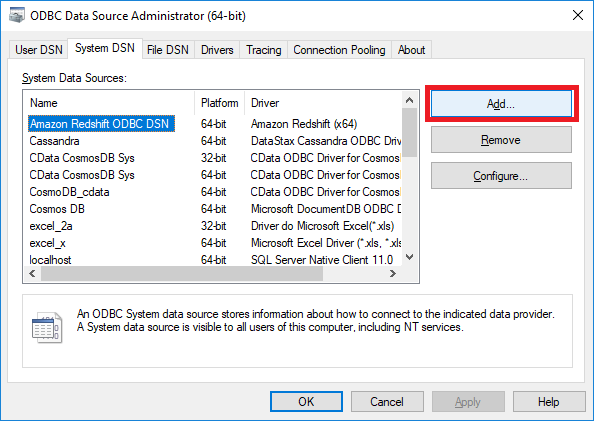

- #Install odbc excel driver how to
- #Install odbc excel driver install
- #Install odbc excel driver drivers
- #Install odbc excel driver download
In this case, you can choose whether to display the imported data as a table, a PivotTable report, or a PivotChart. You can also connect to the NetSuite data source using the Data Connection Wizard or Microsoft Query and select the tables you would like to import into your Excel workbook. Using Data Connection Wizard or Microsoft Query For example, if you add too many custom fields to the Transaction record type, exceeding the 999 fields per table limit, you may get the following error: “Error: Could not find any column information for table:transactions”. This may happen when querying over tables that have many custom fields or when joining multiple tables in a single query and trying to retrieve all their fields. For more options, expand this menu and click Close & Load To.ĭue to an Oracle limitation, queries over SuiteAnalytics Connect schema tables including more than 999 fields will not run. By default, your data will be loaded to a new worksheet. When ready, click Close & Load to load your query data to your Excel workbook. To learn more about the Query Editor, see. You can rearrange the columns in your query, removing those you do not need.

#Install odbc excel driver install
Install the ODBC driver that matches the requirements of your SQL client tool. Before you install an ODBC driver, determine whether your SQL client tool is 32-bit or 64-bit.
#Install odbc excel driver drivers
Provide your NetSuite login and password, if prompted, and click Connect. Amazon Redshift provides ODBC drivers for Linux, Windows, and macOS X operating systems. In this case, try running the query again, adding an explicit query statement in the SQL Statement field. You have 2 ODBC Administrators, 32bit (run c:\Windows\SysWOW64\odbcad32.exe ) and 64bit (run c:\Windows\System32\odbcad32.exe ). However, there can be Excel limitations to using this option. The ODBC driver from Oracle is available for 32bit and 64bit, the Microsoft driver exits only for 32bit. If you don’t add any query in the SQL Statement field, you can click OK and select a table or a set of tables you want to open in the Query Editor. To learn more about the Connect Browser, see Working with the Connect Browser. To explore the tables available in the Connect schema, you can use the Connect Browser. For example, to run a query over all columns in the Service Items table, enter select * from service_items. For DSN-less connection string options, see Connecting Using a Connection String.Įxpand the SQL Statement area and enter your SQL query.
#Install odbc excel driver how to
To learn how to check your NetSuite DSN, see Configuring the ODBC Data Source on Windows. In the connection string field, type DSN=NetSuite to use the Connect driver DSN for connection. In Microsoft Excel, go to the Data tab and select New Query > From Other Sources > From ODBC. However, if you use Microsoft Excel 2010 or 2013, you can install the Power Query add-in to be able to use this option. This option is available starting with Microsoft Excel version 2016. One of the most convenient ways to run a database query in Microsoft Excel is to use the New Query option. To learn how to test your connection, see Configuring the ODBC Data Source on Windows.
#Install odbc excel driver download
To learn how to download and install the driver, see Downloading and Installing the ODBC Driver for Windows. Use Microsoft Query over a table or a set of tables and load the results to an Excel worksheet.īefore you can configure Microsoft Excel to pull data from the SuiteAnalytics Connect data source, you need to download and install the latest SuiteAnalytics Connect ODBC driver and make sure it is connected to your NetSuite data source. Use Data Connection Wizard to load the table data to an Excel worksheet. Run a query over a set of tables in the Connect schema and load the results to an Excel worksheet. That’s a real work of art.You can use the SuiteAnalytics Connect ODBC driver to load your NetSuite data to Microsoft Excel workbooks.

It looks like you’ve put a lot of work into this.


 0 kommentar(er)
0 kommentar(er)
